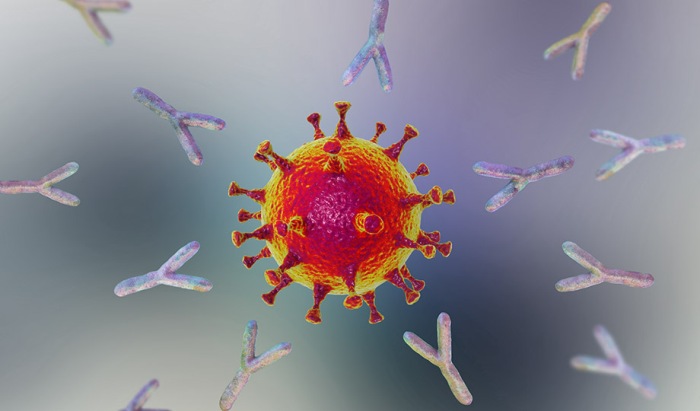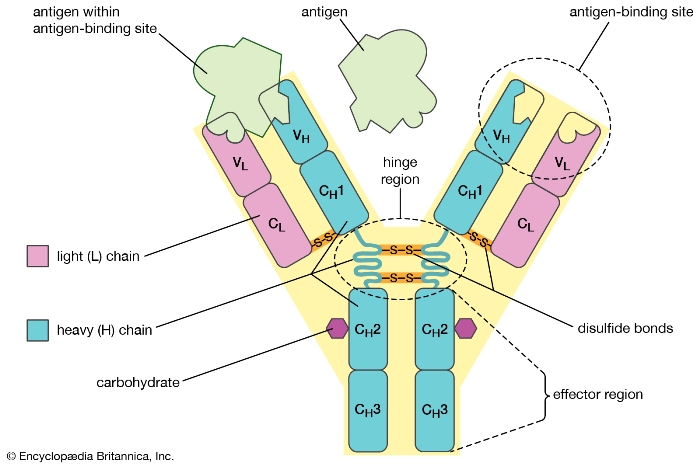
Antibodies attacking SARS-CoV-2 virus, the conceptual 3D illustration for COVID-19 treatment, diagnosis and prevention
Medically reviewed by Angelica Balingit, MD — Written by Gillian D’Souza

Antibodies are disease-fighting proteins in the body that play a crucial role in the immune system. Much like a search battalion, antibodies recognize infectious invaders such as bacteria and viruses and help the body eliminate them.
Antibodies develop in response to an infection or enter the body passively through vaccination. An antibody is sometimes called an immunoglobulin. But not all antibodies are immunoglobulins, just as not all immunoglobulins are antibodies.
White blood cells called plasma cells produce antibodies during the course of an infection. A single plasma cell can secrete several hundreds to thousands of antibodies a secondTrusted Source in order to create a powerful immune response.
Keep reading to learn more about antibodies, including how they work, the types, and more.
What do antibodies look like?
Antibodies are Y-shaped proteins. The base of the antibody (the vertical leg of the Y) helps it communicate with other components of the immune system. The tip of the antibody (both arms) can bind to foreign invaders. These invaders, either in whole or in part, are called antigens.
Each antibody has a total of four protein chains: two light and two heavy chains, arranged in a light-heavy-heavy-light structure. The light chains weigh approximately 25 kilodaltons (kDa), and the heavy chains about 50 kDa.
The tip of the antibody consists of both light and heavy chain portions. Scientists call this tip the “antigen binding site” or paratope.
Antibodies have a 3D structure, which helps them bind to thousands, even millions, of different antigens with precision. Owing to their high specificity and affinityTrusted Source for diverse antigens, antibodies are a valuable and indispensable tool in diagnostics and treatment.
How do they work?
Antibodies develop during an infection or in response to a vaccine. Each antibody is specific and has one of two precise tasks: tag an invader for destruction by other immune cells, or destroy the invader by itself.

An antibody can recognize and bind to an antigen in a specialized lock-and-key manner. This binding triggers the body’s immune response and mobilizes other cells to fight the invading antigen.
After the immune system tackles and eliminates the antigen, it creates antibody-producing memory cells, which remain active in the body long after recovery. These memory cells ensure the body stays better prepared with a swifter immune response if ever exposed to the same antigen again.
According to the Centers for Disease Control and Prevention (CDC)Trusted Source, the duration that antibodies offer immunity differs from person to person. The duration also differs from one disease to another.
Furthermore, antibodies that develop in response to a measles infection will protect a person from a future case of measles but do not offer immunity from, for example, dengue or COVID-19.
Antibody types and location
There are five classifications of antibodies, each based on the antibodies’ structure and location in the body.
Immunoglobulin G (IgG)
IgG is the smallest and most abundant antibody in the system, consisting of about 80% of the immunoglobulins. It is the only antibody that can travel across the placenta from parent to fetus. This provides natural passive immunity to the fetus. IgG is a general-purpose antibody, protecting against infectious agents that are active in the blood and tissues. It plays a key role in establishing post-infection immunity.
Immunoglobulin A (IgA)
IgA is the second most abundant antibody, making up about 10–15%Trusted Source of the immunoglobulins. It is commonly present in body secretions such as colostrumTrusted Source (first milk), saliva, sweat, and tears. IgA acts as the first line of defense for mucosal surfaces that come in contact with an antigen. It prevents the attachment of bacteria and viruses to the body’s epithelial cells. IgA also works by neutralizing bacterial toxins and viruses.
Immunoglobulin M (IgM)
IgM is the largest antibody by size, but makes up only 10% of all immunoglobulins. It is comparatively heavier than the other antibodies. IgM is the earliest antibody that the fetus produces before birth. It is largely present in the intravascular space and is responsible for protection against blood infection. This is why healthcare professionals often link IgM deficiency to septicemia.
Immunoglobulin D (IgD)
IgD is less understood compared with the other immunoglobulins. It is present in the tissues that line the chest and abdomen. Although IgD’s role in the immune response is unclear, an EU study in 2015 showed high levels of IgD in people with inflammatory autoimmune diseases such as systemic lupus erythematosus. Another 2016 studyTrusted Source showed elevated levels of IgD in people with rheumatoid arthritis. That said, researchers must continue to investigate the link between IgD, immunity, and inflammation.
Immunoglobulin E (IgE)
IgE is the least abundant antibody in the system, present in trace amounts in serum. IgE levels rise when the body reacts to pollen, animal dander, and fungus spores. It is present in high amounts in people with asthma, hay fever, and eczema. IgE develops in the linings of the respiratory and intestinal tracts. It also plays a role in inflammatory reactions, hypersensitivity, and helminthic infections.
Antibody vs. antigen
Because of their inter-relationship in disease, researchers often discuss antibodies in the context of antigens. But the two are distinct opposites in their composition and behavior.
An antibody is a protein that develops in response to a foreign invader (the antigen). An antigen can be a protein, lipid, carbohydrate, or nucleic acid.
Antibodies are an essential component of the immune response and protect against disease, while antigens usually induce a harmful body response or allergic reaction.
Some antibodies are known as immunoglobulins, while antigens are called immunogens.
Another key difference between antibodies and antigens lies in their place of origin. An antibody develops within the body, while antigens are foreign to the body and have external origins.
While antibodies remain in the body for several weeks to years after an infection, antigens are swiftly neutralized, or eliminated, to help prevent or contain infections.








Your writing style is unique compared to others I have read. Barbette Quent Dillon